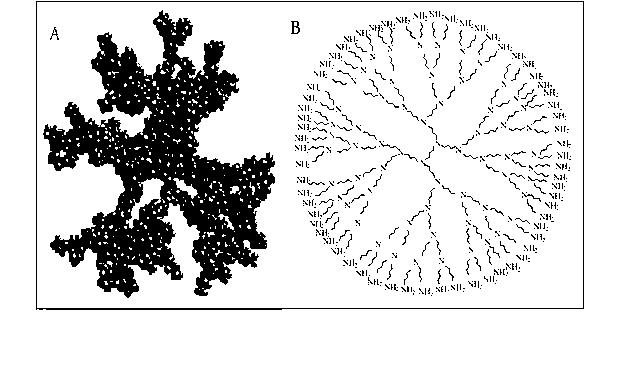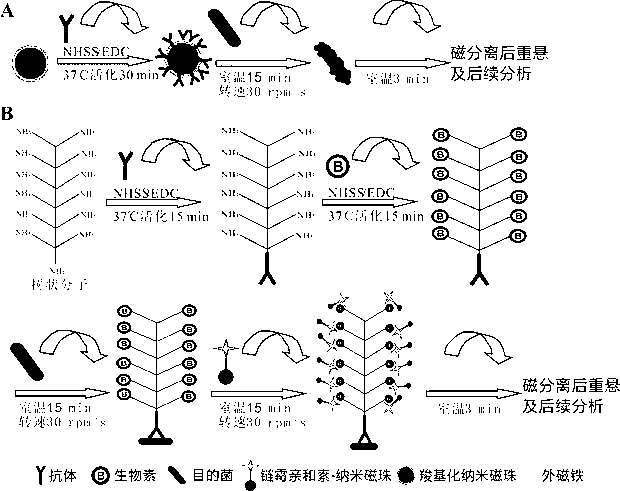Method for enriching and separating listeria monocytogenes
A technology for the proliferation of Listeria and monocytogenes, applied in the field of isolation of food-borne pathogenic bacteria, can solve the problems of separation failure, high concentration of miscellaneous bacteria, changes, etc., to increase the chance of contact, stabilize the reaction solution, and improve the capture efficiency effect
- Summary
- Abstract
- Description
- Claims
- Application Information
AI Technical Summary
Problems solved by technology
Method used
Image
Examples
Embodiment 1
[0030] 1. The dendrimer-antibody complex is prepared according to the following steps:
[0031](1) Dissolve 1.0 mg dendrimer in 2 mL phosphate buffered saline (PBS, 0.02mol / L, pH 6.5), add 0.6 mg N-hydroxysuccinimide NHSS, 0.4 mg ethyl 3-(3 -Dimethylamino) carbodiimide hydrochloride EDC, stirred on a mixer at room temperature, and activated for 15 min;
[0032] (2) Take 10.5 mg L m The specific antibody was added to the above reaction solution, placed on a mixer at room temperature and stirred for 30 min;
[0033] (3) The above solution was spin-dried under reduced pressure, dissolved in deionized water, and dialyzed in PBS and deionized water for 1 day; after the dialysis, the obtained solution was freeze-dried.
[0034] 2. The long-chain biotin-dendrimer-antibody complex is prepared according to the following steps:
[0035] (1) Dissolve 15 mg long-chain biotin, 3.6 mg NHSS, and 2.4 mg EDC in 2 mL 0.02 M pH 6.5 PBS buffer;
[0036] (2) Add 0.53 mg dendrimer-antibody com...
Embodiment 2
[0040] Example 2 Enrichment effect experiment
[0041] (1) Take 1 mL of concentration as 10 4 cfu / mL L m Centrifuge at 12,000 rpm for 5 min in a 1.5 mL sterile centrifuge tube, discard the supernatant, and resuspend with an equal volume of sterile PBS solution.
[0042] (2) Enrichment and capture: respectively set the technical solution group of the present invention ( L m dendrimers co-modified with antibodies and long-chain biotin), L m Specific antibody-modified nano-magnetic bead set, L m Specific antibody-modified micron magnetic bead group enriches target bacteria.
[0043] (3) After magnetic separation, pour the supernatant into a sterile centrifuge tube, and capture the L m The immunomagnetic beads were washed twice with PBST, mixed well, and the immunomagnetic bead complex was resuspended with 1 mL sterile PBS solution.
[0044] (4) Capture rate calculation: After gradient dilution of the enriched target bacteria resuspension in each group, count each grad...
Embodiment 3
[0057] Example 3 Enrichment capture experiment
[0058] Conventional magnetic stand separation time is 30 min, all the other are with embodiment 2.
[0059] The catch rate of each group is as follows:
[0060] L m Capture efficiency of specific antibody-modified micron magnetic bead sets L m Capture efficiency of specific antibody-modified nanomagnetic bead sets L m Capture efficiency of dendrimers co-modified with antibodies and long-chain biotin 60.1% 40.6% 92.8%
[0061] Experimental result shows, separates 3 min among the comparative example 2, and when separation time reaches 30 min, the capture efficiency of three groups has all been improved, especially L m The capture efficiency of the specific antibody-modified nano-magnetic bead group is the most obvious, which shows that the capture efficiency of the nano-magnetic bead group can be greatly improved by extending the time, but it is still lower than the short-time separation (3 min) L...
PUM
| Property | Measurement | Unit |
|---|---|---|
| particle diameter | aaaaa | aaaaa |
Abstract
Description
Claims
Application Information
 Login to View More
Login to View More - R&D
- Intellectual Property
- Life Sciences
- Materials
- Tech Scout
- Unparalleled Data Quality
- Higher Quality Content
- 60% Fewer Hallucinations
Browse by: Latest US Patents, China's latest patents, Technical Efficacy Thesaurus, Application Domain, Technology Topic, Popular Technical Reports.
© 2025 PatSnap. All rights reserved.Legal|Privacy policy|Modern Slavery Act Transparency Statement|Sitemap|About US| Contact US: help@patsnap.com


